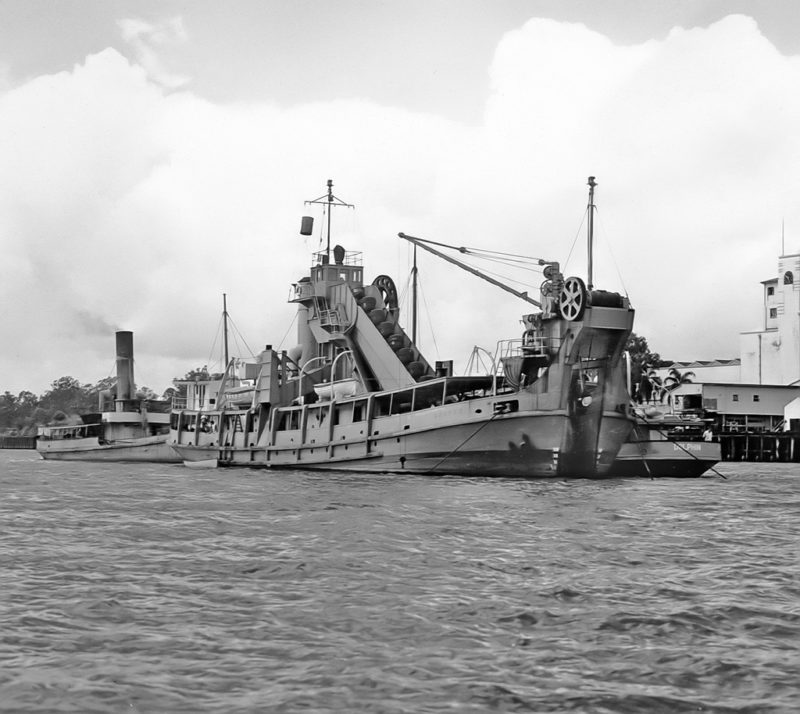
Someone once said ‘everyone has a story in them and in some people that’s where it should stay’ but for me it unlocked a lot of things. These are a mixture of tales of my youth and adulthood in the Australian maritime industry, not just my seagoing years but also the time I worked in allied maritime parts of the industry that are equally important such as the ship berthing crew, as a ships agent, a lecturer of maritime studies and an examiner for marine certificates of competency and service in the Royal Australian Navy Reserve forces. It was never intended to be literature or scholarly but to bring back to life, in both positive and negative aspects, the memories of a life that existed, before those memories are gone forever.
A Very Ordinary Deck Boy
Having left school at age 14 with a very limited education (mostly of my own making), it was necessary for me to get any sort of work. I knew what I wanted to do and that was to go to sea in the Merchant Marine, following in the footsteps of my two older brothers but this was clearly out of my reach just yet because of my age. An advert in the morning paper for a messenger boy at a well-established sporting goods store in the Brisbane CBD set me on the path to my first job. It wasn’t a particularly unpleasant job, but more importantly for me was that it gave me the time and opportunity to make an application for a job as deck boy with the Queensland Department of Marine and Harbours who were responsible for a large fleet of dredgers, hopper barges and small tugs working along the Brisbane River. At age 14 this was the nearest I could get to work in the maritime industry as you had to be 15 to go to sea. By good fortune and the efforts of my eldest brother, some six months later I was offered a position as deck boy on the dredger Groper on the Brisbane River.
This was a ‘ladder type bucket dredger’ which meant it had an endless chain of very large buckets extending from the top of a high tower down to the floor of the river. Once started these buckets traveled continuously with the empty bucket on the downward sweep into the water, scooping up a load of mud and sediment then coming out of the water on the upward travel. When the bucket reached the top of the ‘ladder’ it would spontaneously ‘tip over’ and empty its contents onto an angled ramp positioned to spill the mud into the hopper of a motorised hopper barge moored alongside. When the hopper barge was full it would be cast off and another barge would immediately take its place alongside. The noise of the grinding chain of buckets was continuous and ear splitting (no ear protectors), the mud and sediment being dredged up from the riverbed gave off a constant stink and when the mud was tipped out of the bucket onto the angled ramp some of it would splash over the side of the ramp onto the deck of the dredger making it very slippery. No Occupational Health & Safety concerns!
Early the next morning I arrived at the jetty to board the crew ferry with about 20 other seaman and be transported to the Steam Dredger Groper. On arriving alongside the dredger, I had to manage to get across from the small moving tug onto the dredger without injuring myself, a tricky manoeuvre when you have never done it before. Once onboard work started immediately preparing the officers mess room for lunch, cleaning the officers’ cabins, serving the officers their meal, cleaning up after their lunch, cleaning the crews mess rooms, washing their dishes (they collected their meals themselves from the galley), cleaning the toilets and showers. Then a quick shower and be ready by 4.30 pm to jump back onto the crew ferry tug for transport back to the jetty. After 6 months of this I was 15 and ready to go to sea.
At that time the Australian Maritime Industry was heavily unionised which meant I had to join the Seaman’s Union of Australia at the first opportunity. I was given half a day off one afternoon and made my way to the ‘union rooms’ in the Trades Hall building. I was told to have a head and shoulders photo with me. The union official gave me a pep talk about the value and importance of being a loyal union member, I took the ‘Oath of Fealty’ which is a medieval pledge of allegiance, in this case to the union, I paid my membership joining fee and the first quarter ‘union dues’, my photo was pasted onto the front cover of my ‘union book’, and I was now a proud member of the Seaman’s Union of Australia.
Next was to the Government Mercantile Marine Superintendent (the Shipping Master) only to be told I had to have a letter from my father agreeing to me going to sea and stating my date of birth which I duly obtained.
Next was an eyesight test with the government ‘shipping doctor’, the standard letter test for long vision, the Ishihara colour test for red/green colour deficiencies which I passed and was given the report to take back to the Marine Superintendent. Nowadays you also have to pass a lantern test where you are placed in a dark room and red, green, or white lights would appear in various combinations that you had to identify. Gradually the intensity of the light on display was lowered until it was nothing more than a spec of light.
Finally, a medical and a chest X-ray at a Government clinic to check for TB which was rampant through the 1950s. On passing this I was issued with a card showing that my ‘lung fields ‘were clear. The Marine Superintendent told me to always carry it with me as it was an essential part of signing on a ship when I got a job. Because of the infectious nature of TB and the close living arrangements onboard many of the ships in that era the X-ray had to be repeated annually and a new card issued that had to be current when signing on a ship. Some years later this requirement was abandoned as it was realised that the effects of regular annual X-rays could also be detrimental to your health due to the radioactivity of X-rays.
Advancement from deck boy to the next higher rank of ordinary seaman required 12 months sea time on a seagoing merchant ship and this was the basis for most deck boys who had a job staying on their ship until ‘they got their sea time in’. While there were many Australian manned merchant ships trading on the Australian coast at this time not all of them carried a deck boy as part of the manning scale. It all depended on the size and tonnage of the ship. Some would carry none, most would carry one and the larger tonnage ships would carry two. For the unemployed deck boy this could mean a long stay on the engagement roster. I attended the engagement ‘pick up Centre’ between 10 and 11 am daily. At week five a job came up on the ship Manunda a large coastal passenger ship.

TSMV MANUNDA
After I was allocated the position, the union official told me to wait while he spoke with the Shipping Master. On his return he marched me (literally) down to the street level of the building where I was told to approach the counter. Behind the counter were the ship’s Captain and the Shipping Master. Behind them were several office clerks, mostly young girls, and standing behind me on my side of the counter were several able seamen who were there to sign on the ships they had been ‘picked up’ for that same day.
The ship’s Captain and the Shipping Master looked at me sternly and proceeded to read some of the Articles of Agreement that I was about to sign. The Shipping Master particularly concentrated on the offences and penalties. When asked if I understood I gave a timid ‘yes sir’ and the whole audience broke into laughter. I signed the Articles of Agreement and was told to be onboard the ship at 0800 the next morning.
The Articles of Agreement are a standard document that links you by agreement to serve under the ship Master (the title Captain is just a courtesy title) and follow his/her lawful commands. They usually run for a period of 6 months, but you are free to ‘pay off’ the ship at any time during this period. Modern day Articles are much different.
Built as a passenger/cargo ship it was one of the largest ships in the Australian coastal passenger/cargo service at that time (1929). During World War II it was converted to a Defensively Equipped Merchant Ship (DEMS) and then as a hospital ship and saw service in the Middle East and Pacific Campaigns, specifically New Guinea as well as being bombed and damaged in the Japanese raid on Darwin in 1942. She resumed her commercial passenger duties in 1948 before being sold to a Japanese company and finally broken up in 1957.
I arrived at the ship the next morning before 0800, found the Bosun (the senior seaman rating), found my cabin, a two-berth cabin shared with the other deck boy and was given one hour to unpack and get into my working gear and start working. My shared cabin was outside the forecastle but still in the bow of the ship. It was spartan, just a bunk bed, a small wardrobe and a couple of drawers under the bunk. Other crew accommodation was inside the forecastle including the mess room, crew galley and one deck down, the toilets, showers and laundry, a fancy word for a couple of steam water boilers and water troughs for hand washing your clothes. No washing machines. The mess room had about 12 individual tables each with four chairs.
My first exposure to this strange environment was at lunch that first day. A large pot of soup sat in the middle of the mess room servery for self-serve. The main meal was served direct from the galley just inside the entrance to the forecastle. I carried my plate into the mess room and not sure where to sit I was politely directed to a chair at one of the tables. Not being any the wiser I sat in this chair. No sooner had I started eating when a figure stood beside me and told me in a very few words that I was sitting in his chair. It seems, as I was soon to find out, that several of the crew had been with the ship for many, many years and had a personal connection to their chair, some even having a name plate on the back of their particular chair. Once again this was a set-up and the person who politely directed me to this chair did so intentionally fully knowing what was going to happen. The whole mess room burst into laughter.
After lunch, work continued until sailing time at 8 pm. The role of the two deck boys on departure was for each one to work independently to heave a fender from the wharf level back to deck level using a block and tackle arrangement. The process was simple but each of these fenders was really very heavy, and I was skin and bones. When it came time for me to haul on the tackle and raise my fender, nothing happened! I simply was not strong enough. Several adult male passengers lining the ships rail alongside me observed my difficulty and to the amusement of other nearby passengers promptly stepped in and hauled the damn thing up to deck level for me.

When this situation was told to the Bosun the next day he reluctantly accepted that the technique would have to be changed to accommodate me as it was clear there was no way I could raise the fender on my own and it was simply not an option to use passengers. Step in the union delegate. All Australian coastal ships had two seamen from the crew who were elected to be the union delegates. After some discussion between the Bosun and the union delegate it was decided that in future, after leaving the wharf the fenders were to be left hanging just above the level of the water until both of us deck boys could work together hauling up one fender at a time.
The trip down the east coast to Sydney was reasonably calm and I was happy. At last, my career was underway. I soon adapted to the daily work routine of assisting in hosing down the decks, polishing brass and painting. Passenger ships love brass, it was everywhere, even the ships horn located near the top of the funnel was made of brass and I had to polish it. It wasn’t long before the quality of my work clothes became an issue. All I had was my dredging work clothes, a pair of damaged jeans, tee shirt, a short leather jacket and volley tennis shoes. Several of the crew gave me some more suitable working clothes to wear until we arrived in Sydney where I would have to buy a new rig. This I duly did with a set of ‘passenger blues’, dark blue shirt and trousers and flat white seamen’s cap. We sailed to Melbourne, Sydney, Brisbane, Townsville and Cairns. The daily routine now involved learning seamanship skills, being tutored by skilled seamen, tying knots, splicing, rigging blocks and tackles, changing items of cargo gear, having to learn verbatim how to ‘box the compass’ (in quarter points) as preparation to being allowed to take a turn at steering the ship under the close watchful eye of the seaman watch keeper and the watch keeping officer. One hour per day was given to me for steering practice while the ship was at sea.
At some point during my time on this ship an industrial dispute developed between the union and the shipowner resulting in the union instructing the ship delegates to hold the ship in port overnight by refusing to sail. The union delegates passed this decision (refusing to sail) on to the Master who ordered that all the crew be lined up on the saloon deck. The delegates knew this would happen as the Master had no alternative but to order each person to take the ship to sea or be penalised under the terms of the Articles of Agreement. The union delegates called a meeting, and it was agreed that when ordered to take the ship to sea by the Master each individual would say ‘no’. As I was the deck boy and really only on industry probation the union delegate told me to say ‘yes’ when asked. We lined up and the Master walked along the line saying to each, “I’m ordering you to take the ship to sea” and receiving a firm “no”. When he got to me and said, “I’m ordering you to take the ship to sea”, I was struck dumb. He hesitated and repeated the order as he had to have a verbal ‘yes’ or ‘no’ at which point the union delegate raced along the line and said to me ‘say yes’, as it was a legal requirement that the acceptance or refusal had to come from me. If memory serves me right the crew was ‘logged’ one day’s pay for refusing a lawful command of the Master. The ship was delayed overnight, which was the intention, and sailed the next day. I remained on this ship from April to August 1956 and would have stayed longer were it not for catching a respiratory infection and having to be discharged in Sydney for treatment then repatriated to Brisbane. This meant I had to go back on the roster and wait for another ship.
A loyal brother came to my rescue. Knowing I was on the roster in Brisbane and knowing there was a job for a deck boy the next day in Newcastle where his ship, the Dandenong, was berthed, he sent me a telegram (no email or text messages or mobile phones at this time) telling me of the job and strongly suggesting that I get to Newcastle that day as the job would appear on the board at the ‘pick up’ the next day. I had never been to Newcastle before so after a short flight from Brisbane I booked into a seaman’s hotel near the wharf, close to the ‘pick up shed’ and went in search of Graham’s ship that I knew to be berthed somewhere in the port.
By now it was dark and wandering along the poorly lit waterfront was uneasy (wharf buildings never at any time look inviting, especially after dark) but I found his ship only to see that it was about to sail. We had time for a quick hello and for him to give me directions on how to get to the union rooms where I had to get my name on the roster before anyone else if I was to get this job.
Alone in Newcastle in a broken-down seamen’s hotel waiting for dawn to break so that I could find my way to the union rooms, it was a long night. I arrived at the union rooms at 8 am just to be sure I was first although I knew they did not open until 9am. At 9am with no one else in sight I had my name placed at the top of the roster. At 10am when the ‘pick up’ commenced the first job to be placed on the board was ‘one deck boy for the Bulwarra. I handed over my roster card to the union official, signed on at the shipping office and told to be onboard by 1300. I was onboard by 1200.
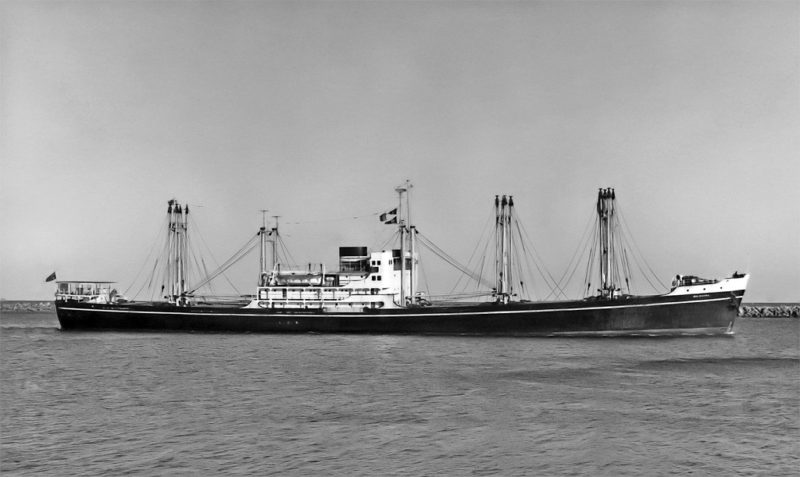
MV Bulwarra
The Bulwarra was built at the Evans Deakin shipyard in Brisbane in 1954 for the Australian Shipping Board and transferred to the Australian National Line in 1957. She was sold in 1970, renamed Collin Five and broke up in heavy weather off Keelung in 1971.
In that era, it was normal practice when anyone joined an Australian union manned ship to show their union book to the ship delegate on first boarding. As it was 1200 the crew was having the midday meal, so I stepped inside the mess room and asked for the delegate. No one knew who I was but guessed that I was the new deck boy and one person pointed me to a very old short, fat Greek looking person who was sitting in a chair in the corner of the mess room asleep. I walked over to him and said, “I’m the new deck boy” and flashed my union book. He opened his eyes, looked at me and then closed his eyes again. Everyone in the mess room broke into laughter. He wasn’t the delegate, just the crew attendant. The real delegate identified himself and the ritual of checking my union book was completed and I was shown to my cabin.
This ship was different. It was a real cargo ship. No polishing brass or struggling with fenders. This ship had cargo holds, tween decks, 16 cargo derricks and one heavy lift jumbo derrick. And I was part of it, out there on deck with all the other seamen, doing seamen’s work. And not on a regular run like the Manunda. This ship would tramp to different ports, on this voyage including Newcastle, Sydney, Esperance, Fremantle, Kwinana, Adelaide, Whyalla, Melbourne, Townsville and finally again to Melbourne in just four months when the company decided to put the ship into layup and I returned to Brisbane. After two weeks on the roster in Brisbane a job came up on the SS Bungaree in Mackay.
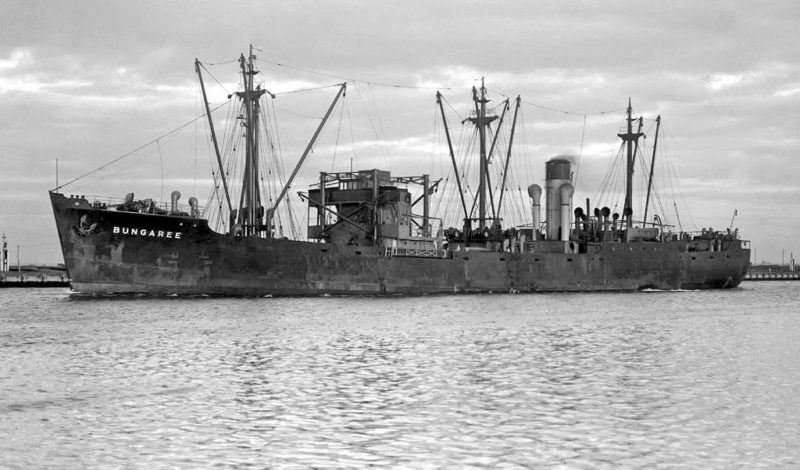
SS Bungaree
The Bungaree was built by the Caledonian Shipbuilding and Engineering Company in Dundee in 1937 as a cargo vessel for the Adelaide Steamship Company and registered in Melbourne. Requisitioned as a minelayer during WW2. Sold in 1957 and again in 1960 and 1968. She sank in the Saigon River Vietnam in 1966 after striking a mine.
I was aware that it was an old ship, but I was in for a surprise. It was an absolute wreck, and the crew wasn’t much better. No one wanted to be on this ship. It really was a ‘tramp’ in every sense of the meaning. Although it had served with distinction in World War 2 as a mine layer under compulsory requisition to the Australian Navy it had already had a hard life before that and was nearing the end of its working life. Two-berth cabins, slow, and very uncomfortable in a seaway, living accommodation at the extreme aft end of the ship where all propeller noises and vibrations were heard and felt, steam cargo winches that would cough, and splutter and rattle when in port. Food had to be carried in bulk from the amidships galley across the open aft deck then placed in a heating oven (a ‘hot press’) until eaten by which time it was usually dried out and tough. I can’t remember anything good about my time on this ship or even the ports we went to. Suffice to say that when the company decided to ‘lay it up’ in Sydney in March, I was glad to see the back of it even though it meant repatriation to Brisbane and still several months short of my sea time.
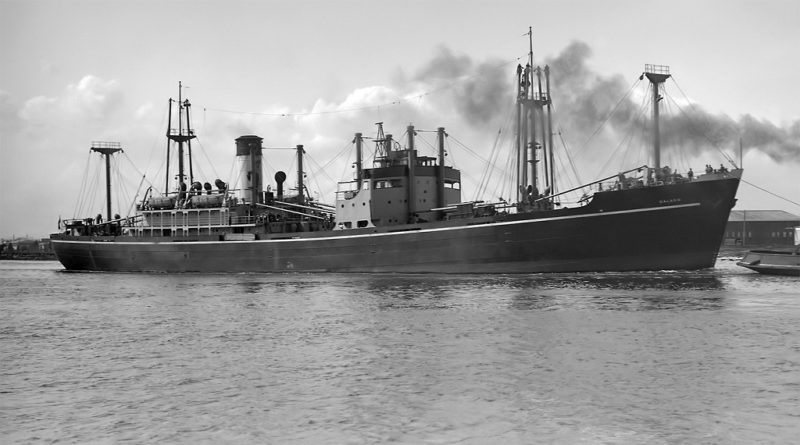
SS Balarr
After two weeks on the roster in Brisbane I joined the SS Balarr. A good ship and crew, trading on a regular run between Brisbane, Sydney, Adelaide and back and with only two months more sea time to become eligible for rating as Ordinary Seaman I was determined that this ship would see me through the last of my qualifying sea time. In fact, with things starting to tighten up in the industry as old ships were being sold or laid up and jobs for ordinary seamen were becoming scarce, I remained on this ship for an extra two months. Fortuitously these extra two months were not wasted as they were counted towards the 24 months required to reach the next rank (Able Seaman) meaning I now only needed 22 months.
The Balarr was built as a general cargo ship at the BHP shipyard at Whyalla South Australia in 1948 initially for the Australian Shipping Board but was sold on delivery to Howard Smith Ltd. It traded on the Australian coast under this name until 1970 when it was sold and again in 1974 before being scrapped in 1976.
In the 1950s when I first went to sea, little was known about the most insidious unknown health effects of the asbestos insulation that was placed around the internal ships piping on steamships such as the Bungaree and the Balarr. Asbestos was popular among shipbuilders because it was resistant to fire, heat, electricity, and chemical damage and, most importantly it was affordable. When a ship was being built the shipyard workers would apply asbestos lagging (thick strings of asbestos) around all of the internal piping in the engine room and pipes that passed through the accommodation under the deckhead. Once the ship was operational it was the task of the ship’s crew to maintain this lagging which would break apart as it deteriorated resulting in loose fibres falling like snow onto the deck and around and over the crew persons who had the job of replacing it. There were no safety measures in place when handling this product and it was not until late in the 20th century that it was identified as toxic and the cause of industrial disease and only then were safety measures put in place. But these measures came too late for many shipyard workers and seafarers who died from cancer and other lung related diseases through exposure to this deadly asbestos.
Demarcation
There was also a Deck Officer Cadet on the Balarr about my age. There was a strict line of demarcation between officers and crew. From time to time there was a relaxing of this when it came to interaction between the two of us. But any interaction was still watched very carefully and never allowed to happen while onboard. We were allowed to go ashore together but only if it was to the Flying Angel Club, also known as the Missions to Seamen, a gathering place where seafarers from all over the world could enjoy some female company and dancing under the strict control of a Padre. We became friends and at a much later time we happened to meet again during a navy exercise while I was in the RANR. He was the Master on a ship, and I was the Navy Boarding Officer, the function of which was to act as a link between Navy MHQ in Sydney and the individual merchant ship master, as it was from the Boarding Officer that the ship master obtained his/her basic instructions, confidential orders, routing instructions and general convoy and self defence guidance books.
CONTINUED NEXT MONTH

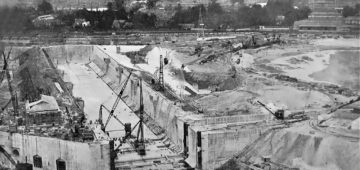


Comments
Sorry, comments are closed for this item